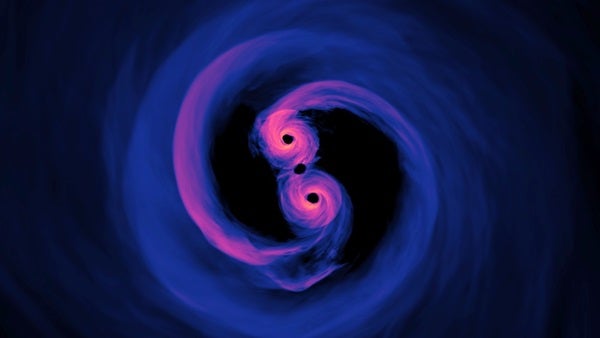What would happen if two supermassive black holes merged?
Supermassive black holes that are millions to billions of times more massive than the Sun are commonly found at the hearts of galaxies. When galaxies merge, their central black holes should also combine. And when they do, these collisions are so powerful that they create distortions in space-time, known as gravitational waves. These ripples were first theorized by Albert Einstein in his theory of general relativity in 1916. Astronomers believe that the power output from the merger of two supermassive black holes would be briefly larger than the combined luminosity of all the stars in all the galaxies in the entire observable universe.
The direct detection of the mergers of two stellar-mass black holes — about 3 to 10 solar masses — by the Laser Interferometer Gravitational-wave Observatory (LIGO) has ushered in the exciting new era of gravitational-wave astronomy. However, the frequency (or wavelength) of the gravitational waves produced by supermassive black hole mergers is significantly lower (longer) than those produced by stellar-mass black hole mergers. This makes them undetectable by LIGO, and so no direct detection of two supermassive black holes merging has been made yet. To make a direct observation, we will need instruments sensitive to the frequency of the gravitational waves produced in supermassive black hole mergers. Such instruments could include ground-based pulsar timing arrays — which use the stable and precise periods of neutron stars to search for gravitational waves — and space-based gravitational-wave observatories such as the Laser Interferometer Space Antenna (LISA), scheduled for launch in the next decade.
When we are able to detect the gravitational waves from a supermassive black hole merger, it will be unlike any other black hole merger we’ve seen before. Most, if not all, stellar-mass black hole mergers detected by LIGO seem to have no accompanying electromagnetic counterparts (that is, events that give off light). But unlike their smaller counterparts, coalescing supermassive black holes are expected to occur in gas-rich environments. This means that bright electromagnetic signals would likely accompany the gravitational waves, making for a truly spectacular show.










